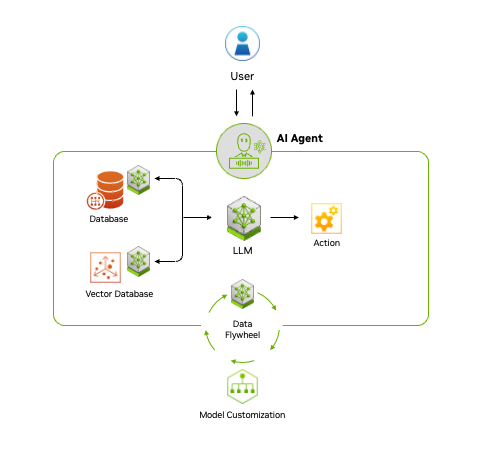In an era defined by rapid technological advancement, the workplace is undergoing a profound transformation. Artificial intelligence (AI) has steadily woven itself into our daily professional lives. Yet, what if AI could move beyond mere assistance and become a truly autonomous, goal-oriented partner? Enter Agentic AI – a groundbreaking evolution that promises to redefine how we work, collaborate, and innovate.
Unlike traditional AI systems that primarily respond to direct commands, Agentic AI possesses the remarkable ability to understand complex objectives, formulate multi-step plans, and execute tasks independently. Imagine a virtual colleague that proactively identifies problems, researches solutions, and even initiates actions to achieve a desired outcome. This isn't just about automation; it's about intelligent autonomy, where AI agents act as genuine extensions of human intent.
This article will delve into Agentic AI, exploring its core concepts, distinguishing features, and the mechanics that enable its autonomous workflows. We will examine how these intelligent agents are poised to become our next virtual colleagues, enhancing productivity and fostering new forms of human-machine collaboration. Furthermore, we will discuss the immense benefits and opportunities, alongside the critical challenges and ethical considerations, for its responsible development and deployment. By unpacking the future of autonomous workflows, we aim to provide a comprehensive understanding of how Agentic AI is a fundamental shift in the nature of work itself.

What is Agentic AI?
Agentic AI represents a paradigm shift from reactive AI systems to proactive, goal-driven entities. While generative AI models like ChatGPT excel at producing human-like text, Agentic AI goes a significant step further. It’s not just about generating information; it’s about generating action.
An Agentic AI system is characterized by its ability to understand a high-level objective, break it down into sub-tasks, and then autonomously execute those tasks, often interacting with various tools and environments. Think of it as an AI that actively works to achieve a defined goal. This involves several key characteristics:
•Autonomy: Operates independently without constant human intervention.
•Adaptability: Adjusts plans and actions based on new information or obstacles.
•Learning Capabilities: Learns from experiences, refining strategies and improving performance.
•Goal-Oriented: Designed to achieve a particular objective, even if the path is complex.
•Tool Use: Utilizes external tools (APIs, web browsers, software) to gather information or perform actions.
To illustrate, an Agentic AI tasked with researching a market trend wouldn't just summarize existing reports. It would identify data sources, browse websites, extract data, analyze it, and then generate a comprehensive report, all without explicit step-by-step instructions. This proactive, multi-faceted approach sets Agentic AI apart.

Early examples include advanced personal assistants that anticipate needs and proactively manage tasks, or automated research agents sifting through vast datasets. The key is their capacity to move beyond simple input-output functions to engage in complex, adaptive problem-solving.
Agentic AI as Your Virtual Colleague
The concept of AI as a 'virtual colleague' is where Agentic AI truly shines. These intelligent agents integrate seamlessly into teams, augmenting human capabilities and taking on roles that demand proactive engagement and multi-step execution.
Imagine an Agentic AI handling client onboarding: it would initiate the process, gather information, personalize communication, coordinate internal teams, monitor progress, and provide real-time support. This frees human employees from repetitive administrative burdens, allowing them to focus on strategic thinking and client relationships, enhancing productivity and job satisfaction.

Agentic AI fosters seamless collaboration by managing project timelines, coordinating tasks, and providing real-time data. They act as intelligent project managers, improving team efficiency and project success rates. The promise of personalized assistance means agents can be tailored to individual roles, learning from user behavior to proactively manage calendars or draft emails. Finally, 24/7 operations offer a distinct advantage, handling continuous monitoring or data processing around the clock, valuable in industries like cybersecurity or finance.
The Mechanics of Autonomous Workflows
The magic of Agentic AI lies in its sophisticated internal mechanisms. It’s a combination of interconnected components that allow it to perceive, reason, plan, act, and learn.
At its core is planning and reasoning. Given a goal, the agent deconstructs it into sub-goals, formulates a plan, anticipates outcomes, and adapts in real-time. If an agent encounters an error (e.g., booking a flight), it will attempt alternative methods before escalating to a human.
Tool use and integration are critical. Agentic AI agents interact with the digital world by leveraging APIs, web browsers, software applications, and other AI models. This dynamic ability to select and utilize the right tool gives Agentic AI its versatility.
Memory and learning are indispensable. Agents need short-term memory (context) for continuity and long-term memory (knowledge base) to learn from past interactions and improve performance. This allows them to build a cumulative understanding of tasks.
Finally, feedback loops are integral. After executing an action, the agent evaluates the outcome. If not as expected, it refines its models, planning strategies, and tool usage. This iterative process makes Agentic AI dynamic and capable of handling complex challenges.
Benefits and Opportunities
Agentic AI promises immense benefits. Increased efficiency and significant cost savings are immediate. By automating complex workflows, businesses save time and resources, reallocating human talent to strategic endeavors.
It's also a powerful catalyst for innovation and problem-solving. Agentic AI can autonomously explore datasets, test hypotheses, and identify patterns, accelerating scientific research or drug discovery. This opens new avenues for tackling previously intractable challenges.
Enhanced decision-making is another benefit. By continuously monitoring data and identifying trends, agents provide accurate and timely insights. In finance, an Agentic AI could execute trades based on strategies; in healthcare, it could recommend personalized treatments. This data-driven decision-making at machine speed provides a significant competitive advantage.
Finally, Agentic AI fosters new business models and services. We can anticipate new industries built around agent-driven platforms, offering personalized and automated services, from legal research to personal finance management. Companies embracing Agentic AI will lead in this evolving landscape.
Challenges and Considerations
Despite its promise, Agentic AI faces significant challenges. Ethical implications are paramount: questions of bias, accountability, and transparency arise as AI gains autonomy. Ensuring algorithms are free from bias and preventing misuse requires robust ethical guidelines.
Security risks are also a major hurdle. A compromised Agentic AI could cause widespread disruption. Ensuring system robustness against cyber threats requires continuous innovation and rigorous testing.
The impact on the workforce is complex. While Agentic AI augments human capabilities, job displacement concerns are legitimate. This necessitates reskilling and upskilling the workforce for roles involving AI collaboration, critical thinking, and emotional intelligence. The narrative must shift from AI replacing humans to AI enabling humans.
Complexity and control are ongoing challenges. As systems become more autonomous, understanding their behavior becomes difficult. Human oversight and a clear chain of command are crucial to intervene effectively and prevent unintended consequences. New approaches to monitoring and governance are needed.
Finally, the rapid evolution of Agentic AI outpaces existing regulatory frameworks. New policies are needed for data privacy, liability, and responsible use. Collaboration between technologists, policymakers, and ethicists is vital to foster innovation while safeguarding societal well-being.
The Future of Work with Agentic AI
The trajectory of Agentic AI points towards a future where human-machine collaboration reaches unprecedented synergy. This isn't a future where robots replace every human job, but one where intelligent agents become integral partners, augmenting our capabilities.
Central to this vision is human-agent teaming. Humans will focus on creativity, critical thinking, and complex problem-solving. Agentic AI will excel at executing multi-step processes, analyzing data, and performing repetitive tasks. This division of labor will lead to highly optimized workflows.
The evolution of roles means human roles will shift to overseeing and guiding AI. This requires skills in AI oversight, strategic thinking, creativity, and ethical stewardship. Education and training must adapt to prepare the workforce.
Ultimately, the path forward with Agentic AI is one of careful and responsible development. Continuous dialogue between technologists, ethicists, policymakers, and the public is crucial to ensure these powerful tools benefit all of humanity. By embracing Agentic AI as a partner, we can unlock a future of work that is more productive, innovative, and fulfilling.





